- A black AKC epitoge on the left shoulder with gold lion embroidery, accompanying the academic dress of King's College London
- A Swiss barrister wearing an epitoge (in this case, both the liripipe and the cape are hanging behind the shoulder)
Related Research Articles

A kilt is a garment resembling a wrap-around knee-length skirt, made of twill-woven worsted wool with heavy pleats at the sides and back and traditionally a tartan pattern. Originating in the Scottish Highland dress for men, it is first recorded in the 16th century as the great kilt, a full-length garment whose upper half could be worn as a cloak. The small kilt or modern kilt emerged in the 18th century, and is essentially the bottom half of the great kilt. Since the 19th century, it has become associated with the wider culture of Scotland, and more broadly with Gaelic or Celtic heritage.
Hakama are a type of traditional Japanese clothing. Originally stemming from kù, the trousers worn by members of the Chinese imperial court in the Sui and Tang dynasties, this style was adopted by the Japanese in the form of hakama in the 6th century. Hakama are tied at the waist and fall approximately to the ankles. They are worn over a kimono specially adapted for wearing hakama, known as a hakamashita.

The square academic cap, graduate cap, cap, mortarboard or Oxford cap is an item of academic dress consisting of a horizontal square board fixed upon a skull-cap, with a tassel attached to the centre. In the UK and the US, it is commonly referred to informally in conjunction with an academic gown as a "cap and gown". It is also sometimes termed a square, trencher, or corner-cap. The adjective academical is also used.

The cassock or soutane is a Christian clerical clothing coat used by the clergy and male religious of the Oriental Orthodox Churches, Eastern Orthodox Church and the Catholic Church, in addition to some clergy in certain Protestant denominations such as Anglicans and Lutherans. "Ankle-length garment" is the literal meaning of the corresponding Latin term, vestis talaris. It is related to the habits traditionally worn by nuns, monks, and friars.

Academic dress is a traditional form of clothing for academic settings, mainly tertiary education, worn mainly by those who have obtained a university degree, or hold a status that entitles them to assume them. It is also known as academical dress, academicals, and, in the United States, as academic regalia.

The academic dress of Durham University has many similarities with that of other older British universities such as Oxford and Cambridge. Most colleges of Durham University insist on gowns being worn on formal occasions, including matriculation and formal halls (dinners); exceptions are Van Mildert, St Cuthbert's Society, Collingwood, Stephenson, St Aidans, and The College of St Hild and St Bede. Some colleges also insist on their being worn to Junior Common Room meetings, and they are often seen in college chapels. At formal halls, only gowns are worn and doctors normally wear their undress gowns; for more ceremonial occasions full-dress gowns and hoods are worn by graduates. Until 1990, the General Regulations of university 'recommended' the wearing of gowns by members of the university when attending divine service at the Cathedral – but this is now left to individual choice apart from at certain services. Gowns are also customarily worn to meetings of the university Senate by members of that body.
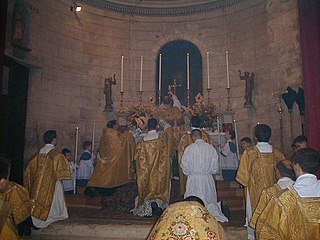
Vestments are liturgical garments and articles associated primarily with the Christian religion, especially by Eastern Churches, Catholics, Lutherans, and Anglicans. Many other groups also make use of liturgical garments; among the Reformed (Calvinist) Churches this was a point of controversy in the Protestant Reformation and sometimes since, in particular during the Anglican ritualist controversies in England in the 19th century.

A hood is a type of headgear or headwear that covers most of the head and neck, and sometimes the face. Hoods that cover mainly the sides and top of the head, and leave the face mostly or partly open may be worn for protection from the environment, for fashion, as a form of traditional dress or uniform, or in the case of knights, an armoured hood is used for protection against bladed weapons. In some cases, hoods are used to prevent the wearer from seeing where they are going. Hoods with eye holes may be used for religious purposes to prevent the wearer from being seen. In the case of Ku Klux Klan members, terrorists, or criminals such as robbers, a hood with eye holes helps prevent identification.

The cope is a liturgical vestment, more precisely a long mantle or cloak, open in front and fastened at the breast with a band or clasp. It may be of any liturgical colour.
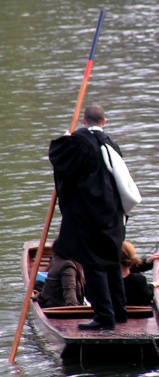
The University of Cambridge has a long tradition of academic dress, which it traditionally refers to as academical dress. Almost every degree which is awarded by the university has its own distinct gown in addition to having its own hood. Undergraduates wear college gowns which have subtle differences enabling the wearer's college to be determined. Academic dress is worn quite often in Cambridge on formal, and sometimes informal, occasions, and there are a number of rules and customs governing when and how it is worn. Black gowns (undress) are worn at less formal events, while on special days full academical dress is worn, consisting of gown, hood and headdress with Doctors in festal dress. The university's officials also have ancient forms of academic dress, unique to the university.

Bands are a form of formal neckwear, worn by some clergy and lawyers, and with some forms of academic dress. They take the form of two oblong pieces of cloth, usually though not invariably white, which are tied to the neck. When worn by clergy, they typically are attached to a clerical collar. The word bands is usually plural because they require two similar parts and did not come as one piece of cloth. Those worn by clergy are often called preaching bands or Geneva bands; those worn by lawyers are called barrister's bands or, more usually in Ireland and Canada, tabs.

A chaperon was a form of hood or, later, highly versatile hat worn in all parts of Western Europe in the Middle Ages. Initially a utilitarian garment, it first grew a long partly decorative tail behind called a liripipe, and then developed into a complex, versatile and expensive headgear after what was originally the vertical opening for the face began to be used as a horizontal opening for the head. It was especially fashionable in mid-15th century Burgundy, before gradually falling out of fashion in the late 15th century and returning to its utilitarian status. It is the most commonly worn male headgear in Early Netherlandish painting, but its complicated construction is often misunderstood.

A full plaid, or just a plaid, is a long piece of tartan fabric, most often worn as part of a Highland dress. It usually matches the tartan of the kilt. A modern full plaid is pleated the whole way, with half of its length sewn shut. Its length is about twice the distance from the ground to the wearer's shoulder.
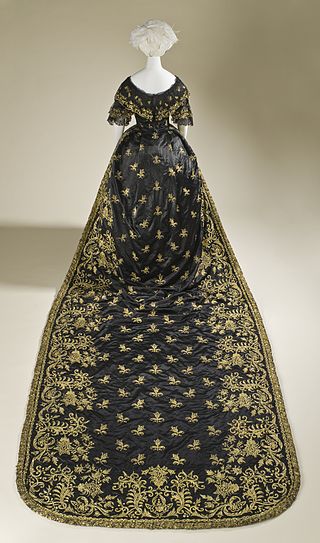
In clothing, a train describes the long back portion of a robe, coat, cloak, skirt, overskirt, or dress that trails behind the wearer.

The preservation of fabric fibers and leathers allows for insights into the attire of ancient societies. The clothing used in the ancient world reflects the technologies that these peoples mastered. In many cultures, clothing indicated the social status of various members of society.

Academic dress prescribed at the Trinity College Dublin follows a relatively complex protocol which, nonetheless, shares some particular characteristics with other universities in Ireland and with the University of Oxford in the United Kingdom.

Academic dress of the University of Manchester describes the gowns, hoods and headwear which are prescribed by the university for its graduates and officers.
The Groves Classification is a numbering system to enable the shape of any academic gown or hood to be easily described and identified. It was devised by Nicholas Groves to establish a common terminology for hoods and gowns to remedy the situation of individual universities using differing terms to describe the same item. As such it is used in same manner as an heraldic blazon whereby a textual description enables a coat of arms to be drawn. The system was first described in the Burgon Society's annual in 2001 and adopted as standard by robe makers and scholars of academic dress.
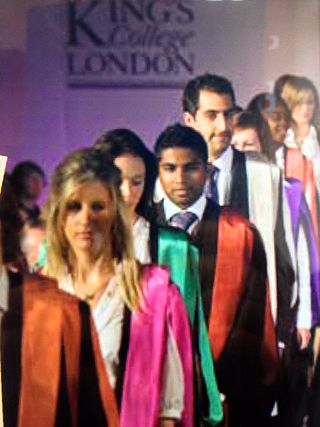
The academic dress of the United Kingdom and Ireland has a long history and has influenced the academic dress of America and beyond. The academic square cap was invented in the UK as well as the hood which developed from the lay dress of the medieval period.
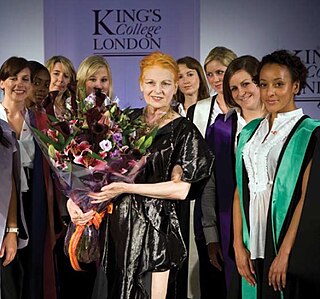
Academic dress of King's College London describes the robes, gowns, and hoods worn by undergraduates, graduates and associates of King's College London. After being vested the power to award its own degrees from the University of London in 2006, graduates began wearing King's College London academic dress in 2008.
References
- 1 2 Groves 2011, pp. 16–17.


